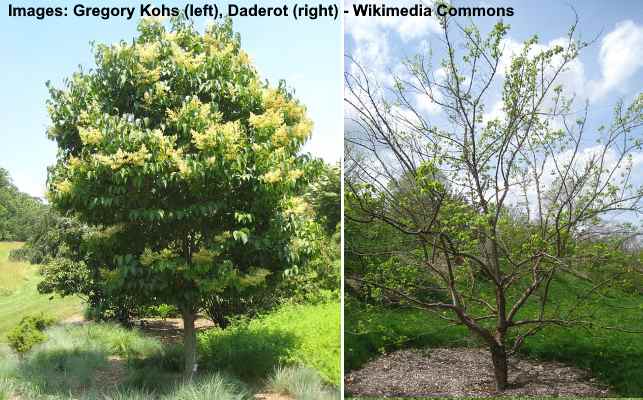Lilac Tree: Care and Growing Guide (with Pictures)

Growing a lilac tree in your garden is surprisingly easy with the proper care and techniques. Lilac is a large multi-stemmed deciduous tree or shrub with conical clusters of fragrant pink, white, or purple flowers. Lilac trees bloom in late spring, and the blooms last for up to four weeks. Their large heart-shaped leaves and dense foliage can provide an ideal privacy fence. Lilac trees are also relatively easy to care for once established in the landscape.
Lilacs are generally considered low-maintenance shrubs. However, suppose you want to grow a spectacular single-stemmed lilac tree in your garden landscape. In that case, you will need to do some pruning to establish the flowering tree. However, any effort is worth it. Once established, a lilac tree produces masses of blooms every year, adding color and fragrance to your front or back yard.
The article is a complete care guide for growing a lilac tree in your yard. In addition, you will also find out about the best lilac plants to grow if you want to grow a hardy tree in your garden.
How to Care for a Lilac Tree
To care for a lilac tree, grow it in full sun and humus-rich, well-drained soil. Water the lilac regularly during spring if rainfall is less than 1” (2.5 cm). In spring, apply compost and mulch around the root area. Remove suckers in spring to retain the tree shape.
Lilac Tree (Syringa vulgaris) Facts

Lilac tree
Common lilac is a large shrub or small tree in the genus Syringa and the olive family Oleaceae. A lilac shrub-like tree grows 8 to 16 ft. (2.4 – 5 m) tall and 6 to 12 ft. (1.8 – 3.6 m) wide. This fast-growing tree has a vase-shaped or round crown, and the dense foliage provides shelter and shade.
Lilac leaves are heart-shaped (cordate) and grow oppositely on woody branches. The large deciduous leaves grow 3” to 6” (7.5 – 15 cm) long and 1” to 3” (2.5 – 7.5 cm) wide. Lilac leaf color is green, and some cultivars have grayish-green leaves.
Most lilac trees grow well in USDA zones 4 through 7.
Is Lilac a Shrub or a Tree?

Lilac is a large shrub or a multi-stemmed tree but can be pruned to have a central trunk
Lilac is classified as a large deciduous shrub or a small multi-stemmed tree. If left to its own devices, a lilac plant produces suckers that form multiple woody stems or thin trunks with light brown or gray bark. Therefore, regular pruning is necessary to remove stems that grow around the central trunk.
There are Syringa varieties that more resemble a tree than a shrub. For example, the Japanese lilac tree (Syringa reticulata) and Chinese lilac tree (Syringa reticulata subsp. pekinensis) have a single trunk, making a small tree rather than a shrub.

Japanese lilac tree (left) and Chinese lilac tree (right)
Lilac Tree Flowers

Lilac flowers can be purple, pink or white
Lilac flowers are the most attractive feature of this easy-to-grow flowering tree. The attractive lilac flowers are conical blooms made up of highly fragrant individual flowers. Each tiny flower has four to five petals. Lilac blooms measure between 6” and 8” (15 to 20 cm) long.
When Do Lilac Trees Bloom?
Lilac trees generally have a short blooming time—just three to four weeks in spring. However, there are varieties of lilac that bloom at different times throughout the season. Planting various lilac shrubs and trees can ensure a longer blooming time for up to six weeks.
Deadheading is one way to extend the blooming time of lilac. Removing flowers near the end of their blooming time has several benefits. First, you help to encourage more flowers to appear. Second, lilac flowers are excellent cut flowers to add a fragrant floral display to your home.
What Do Lilac Tree Flowers Smell Like?
Lilac flowers give off a strong, sweet fragrance that fills the air. The deep, rich floral aromas have hints of vanilla and are like the fragrance of roses. However, if the scent of lilac is too over-powering, then some lilac cultivars have little or no scent.
Types of Lilac Tree
There are hundreds of varieties of lilac trees and shrubs for your garden landscape. Lilac trees have various colors, including pure white, dusty pink, vibrant magenta flowers, and various shades of purple. Some of the most spectacular lilac trees have clusters of multicolored flowers.
Here are some pretty lilac shrubs that you can grow as a small flowering tree:
- Lilac ‘Monge’—A stunning lilac tree with fragrant, magenta-purple flowers blooming in late spring and lasting four weeks.
- Syringa x prestoniae ‘Miss Canada’—This lilac shrub has sweetly scented, rosy-pink flowers that blossom in early summer and last for three weeks.
- ‘Firmament’—A small deciduous lilac tree with pale blue flowers that open from pink buds. The tree blossoms in late spring and early summer.
- ‘Madame Lemoine’—One of the best lilac trees for producing pure white conical clusters of flowers. Lilac bloom time is in late spring, and the flowers persist for up to four weeks.
How to Grow Lilac Trees

Lilac shrubs can be trained to grow as trees with trimming the root shoots around the main trunk and removing side branches from the main stem
It is relatively easy to turn a lilac shrub into a tree. Pruning a lilac bush into a small tree gives your garden landscape a unique focal point. Trimming the root shoots allows you to keep the main trunk and grow a beautiful lilac tree.
The first step in growing a lilac tree involves locating the main trunk. If there seem to be several, choose the straightest and strongest one. Then remove the other branching shoots at ground level using a pruning saw or lopping shears. It’s essential to avoid damaging the main trunk.
The next step is to remove side branches from the main stem. Next, you should trim off the branches from the lower third of the lilac trunk. When cutting the lateral branches, cut at a 45° angle, leaving about 1” (2.5 cm) on the branch. This prevents water from collecting in the cut and helps ensure the lilac tree recovers from pruning.
Once you have a single-stemmed lilac tree, stake the main trunk to provide support. This step ensures the trunk grows thicker and retains its straight appearance. Remove the stake when you are sure the lilac tree trunk can support its own weight.
The only maintenance you need is to remove suckers every spring to prevent the tree from taking on a shrub-like appearance again.
When the lilac tree has reached the desired height, thin the canopy to leave four or five branches. Prune the branches about 5” (12 cm) from the main trunk. Although this type of pruning seems severe, it helps to encourage lateral growth and a bushy, tree-like crown.
When to Plant Lilac Trees
The best time to plant lilac trees is in the fall. Planting the lilac tree before winter allows the root system to be established before vigorous growth the following spring.
You can plant a sucker from a lilac shrub directly in the ground if you want to grow a new tree. A lilac plant has rapid growth, and after four or five years, you should have a large enough shrub to turn into a tree.
Lilac Tree (Syringa vulgaris) Care Guide
With minimal yearly maintenance, you can grow a fabulous lilac tree in your garden. The beautiful upright tree will produce masses of purple, pink, or white lilac blooms in spring. The easy-care tree will then provide plenty of shade during summer and be a focal point in your garden.
Here are some handy tips on ensuring that your lilac tree thrives in your front or backyard.
Where to Plant Lilac Trees
A lilac tree thrives in full sun. So, plant the tree where it gets at least six hours of sunlight every day. Although lilac trees can tolerate some shade, too much will affect blooming. Also, if the tree is in too much shade, you may get problems with powdery mildew.
When choosing the right location for a lilac tree, make sure there is room for growth. A lilac tree canopy can grow up to 12 ft. (3.6 m) wide. And ensuring good air circulation is a vital care consideration to prevent fungal diseases.
Before planting the lilac tree, also check to see that the soil has good drainage. Lilac trees thrive in ground that retains some moisture but never becomes waterlogged, especially if there are frequent heavy downpours.
Here’s a handy tip for testing if the location for a lilac tree has suitable drainage. Dig a hole 12” (30 cm) deep and 8” (20 cm) wide. Fill it with water. If the hole drains within an hour, the drainage is suitable for planting a lilac tree.
Additionally, the best soil for growing lilac trees is alkaline, humus-rich soil. So, it may be best to test the soil pH levels and use garden lime or wood ash to increase alkalinity if necessary.
How to Water Lilac Trees
Lilac trees perform best with deep, infrequent watering. During spring, water the lilac tree every 10 to 14 days until blooming finishes. Then you can water the lilac plant whenever the top layer of ground is dry. Established lilac trees can tolerate short periods of drought.
A newly planted lilac tree requires watering more frequently to become established. Unless there is sufficient rainfall, thoroughly water the young tree once a week to prevent the soil from drying out.
When watering a lilac tree, always irrigate the ground and never water from above. This watering technique ensures that the roots get plenty of moisture to thrive. You also prevent foliage from getting too wet, which could lead to issues with fungal diseases.
A sign that you need to water a lilac tree is if the leaves start to wilt.
Top tip for growing a lilac tree: Spread a 3” or 4” (7.5 – 10 cm) layer of mulch around the root area to help keep the ground moist and prevent weeds from growing.
Fertilizing Lilac Trees
You can fertilize a lilac tree in the second or third year after planting with a balanced tree fertilizer. Use a tree or shrub fertilizer with an NPK ratio of 10-10-10 and apply once a year in spring. Spreading bone meal and fireplace ash over the root area can keep the ground alkaline and encourage blooming.
A word of warning: fertilizing too late in the season can result in lilac bacterial blight affecting your tree’s foliage growth.
How to Prune Lilac Trees
Prune lilac trees just after blooming in late spring or early summer. Pruning this early means that next year’s flower buds have time to grow. Conversely, if you prune a lilac tree too late, you risk chopping off buds that will bloom the following year.
To prune a lilac tree, look for suckers around the trunk and trim them at ground level. Then remove all spent flowers back to the stems to encourage more blooming. To maintain the tree shape, you can cut back one-third of the branches. It may be necessary to remove internal branches to increase air circulation.
How to Transplant Lilac Tree
Lilac trees are easy to transplant. However, it’s always best to transplant a young tree as they adapt better to getting dug up and moved to a new location. The best time to transplant lilac trees is in the fall after the hot summer has passed and before winter arrives.
The first step to transplant a lilac tree is to prepare the new hole. In the sunniest location of your garden, dig a hole twice as deep and wide as the tree’s root ball. Fill the hole with water and allow it to drain. This helps to ensure successful transplanting.
Next, dig around the lilac tree deep and wide. It’s vital to keep as much of the root system intact to prevent transplant shock. Gently loosen and lift the lilac tree from its location. Use a wheelbarrow to transfer the tree to its new location.
Put the lilac tree in the new hole and backfill with the excavated soil. Press down regularly to remove air pockets. Then water thoroughly to remove any remaining air pockets. Until the tree becomes established, keep the soil moist but not waterlogged.
Propagating Lilac Tree
The easiest way to propagate a lilac plant and grow a new tree is by using suckers or softwood lilac stem cuttings.
When the root shoots appear in spring, choose the suckers that are farthest away from the main trunk. Next, drive a shovel into the ground to dig out the sucker and roots. Then put the suckers in a bucket of water if you can’t plant them immediately. Or you can plant the lilac suckers directly in a suitable container containing moist potting soil.
To propagate a lilac tree from stem cuttings, cut three or four softwood stems in spring after flowering has ended. The stems should be 4” to 6” (10 – 15 cm) long. Dip the cut end in some rooting hormone. Place each cutting in a pot filled with a peat-based potting soil mix. Keep the soil moist by misting it regularly throughout the day. It could take up to six weeks for roots to appear.
Once the cuttings are rooted, you can continue growing your small lilac tree in a container. Or you can transplant it to the garden and plant it in a sunny location.
How to Deadhead Lilacs
Deadhead lilacs as soon as the fragrant flower clusters begin to fade and wilt. Cut the flowers back to the stem. Deadheading lilacs encourages more buds to appear and results in better flowering the following spring. Some lilacs are rebloomers, and you may encourage a second round of blooming.
Pests that Affect Lilac Tree Growth
The main pests to affect lilac trees are lilac borers, leaf miners, and oyster-shell scale.
Lilac borers are destructive when they are in the larval stage as long caterpillars. The hungry grubs feast on woody parts of lilac trees. You may notice signs of lilac borers as piles of sawdust on the ground, small holes in branches, and yellowing leaves.
Leaf miners can also affect lilac foliage. The moth larvae burrow through leaves, giving them a blotchy appearance. This can result in the leaves turning brown. Therefore, it’s best to remove all leaves showing signs of leaf miner activity.
Oyster-shell scale is a type of insect that sucks juices from lilac bushes and trees. The scale insects live inside the bark. So, the first signs of an infestation could be darkened gray branches that are rough and bumpy.
Diseases Affecting Lilac Tree Growth
Powdery mildew and lilac bacterial blight are two diseases that can affect lilac trees. The best way to avoid both of these lilac plant diseases is to leave enough room between plants. Lilac tree foliage needs plenty of air circulation to stay healthy. Also, damp conditions can increase the risk of powdery mildew and bacterial blight.
Powdery mildew looks like a white power on lilac leaves. Although the condition is harmless to the plant, powdery mildew makes the tree look sick and unsightly. Find out how to use a milk solution to get rid of powdery mildew from your garden plants.
Suppose the leaves on your beautiful lilac tree look like a blowtorch has scorched them. In that case, it’s probably lilac bacterial blight. The bacterium Pseudomonas syringae pv. Syringae causes severe leaf wilt and browning. The best way to deal with this infection is to remove all affected twigs and foliage and destroy them.
Also, avoid over-fertilizing immature lilac trees and don’t fertilize mature lilac trees late in the growing season. This way, you can help prevent lilac blight bacteria from destroying your tree.
Related articles:
